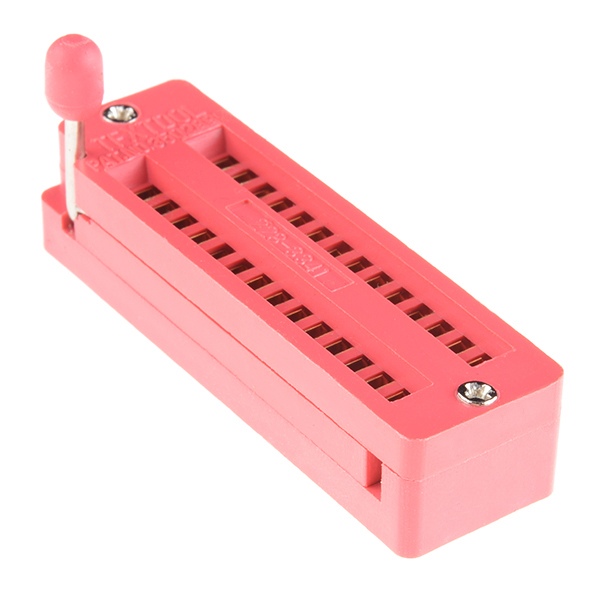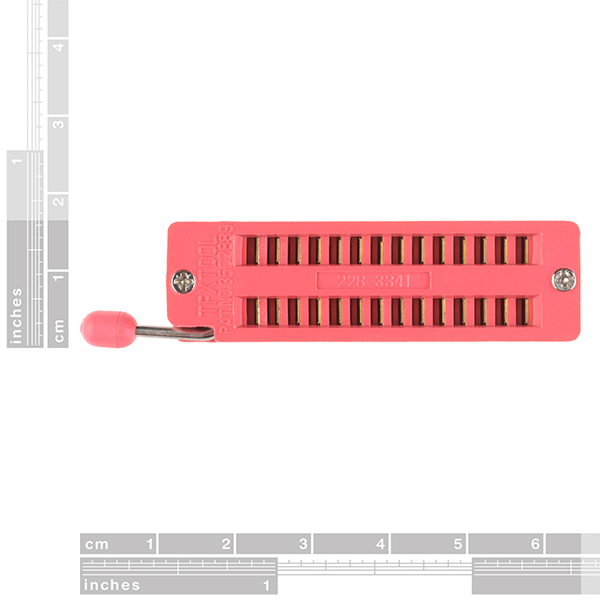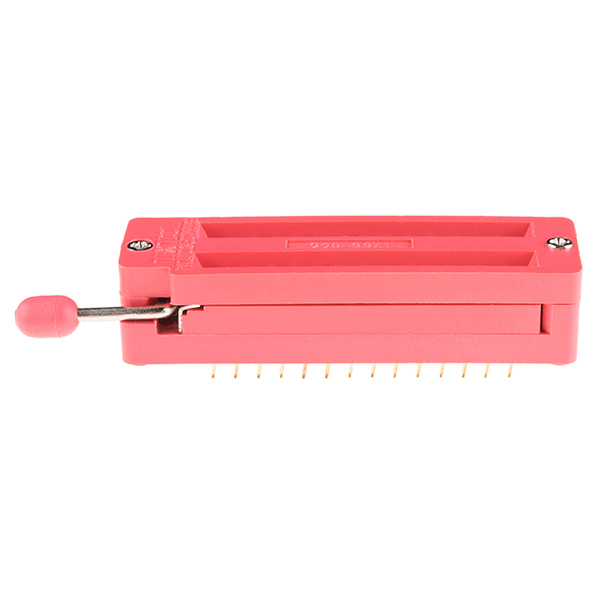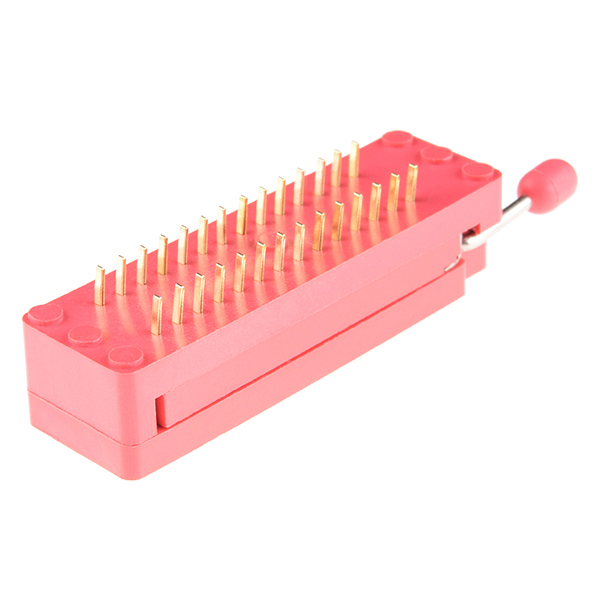ZIF Socket 28-Pin 0.3" Product Help and Resources
Core Skill: Soldering
This skill defines how difficult the soldering is on a particular product. It might be a couple simple solder joints, or require special reflow tools.
Skill Level: Rookie - The number of pins increases, and you will have to determine polarity of components and some of the components might be a bit trickier or close together. You might need solder wick or flux.
See all skill levels
Comments
Looking for answers to technical questions?
We welcome your comments and suggestions below. However, if you are looking for solutions to technical questions please see our Technical Assistance page.
Customer Reviews
3.7 out of 5
Based on 3 ratings:
1 of 1 found this helpful:
Works as expected.
Note that I received a RED one as pictured (pointing that out due to another comment concerning blue ones) and it works as expected. I've had no issues with bad connected and it seats in my breadboard surprisingly well.
1 of 2 found this helpful:
The BLUE ZIF socket not what was received. The RED units do not function properly.
I received the RED version of this device as others have also commented.
I ordered 10 of the 28 pin ZIF sockets and from what I got I think you may have received a bad batch. Out of the 10 sockets I can only get one to work reliably.
You might want to check out a few in your stock.
When I ordered from you I also ordered 10 from ADAfruit (ID 382). Curiously, they have the same part number but they are NOT the same thing.
The ones from Adafruit have a couple of bars across the slot area and they are blueish in color.
The BLUE version from ADAfruit works fine.
The problem with the RED units is they do not fully open. The metal tabs only partially open which prevents a proper insertion of the next chip. I can get one or two open/close cycles on the RED units, then it will fail to open completely. If you remove it from the circuit and snap it a few times it can be made to work again, but that is too much trouble.
The BLUE units I got from ADAfruit all work fine. I think the RED units are some kind of weird rip-off that suffers from a quality issue.
Hi, Sorry to hear that you ran into issues. We'll be happy to check out our stock. Also, if you would like to return the units that did not work, please contact our returns team for more assistance. https://www.sparkfun.com/returns Thanks,
Does what it says on the tin
It's a little tricky with breadboards - it likes to pop out, and requires a little force to push it back in. Otherwise, works quite well. After soldering together a makeshift Uno shield, I've had no problems with it. Opens and closes nicely.






-------------------- Tech Support Tips/Troubleshooting/Common Issues --------------------
ZIF Sockets on Boards with Existing DIP Sockets?
The ZIF Socket has 28 header pins on the bottom. The pins where slightly bigger than a standard DIP chip but I was able to insert the ZIF Socket into one of the 28-pin sockets [ https://www.sparkfun.com/products/7942 ] soldered on an Arduino Uno R3's development board. It required a little bit more force to put into the socket but there was still continuity between the DIP socket pins and the ZIF socket. You just have to make sure that there is enough clearance around your board's DIP socket for the ZIF socket to plug in. Here's one example that illustrates how I was connecting the ZIF Socket onto an Arduino Uno => https://forum.arduino.cc/index.php?topic=348834.msg2413205#msg2413205 .
Note: Keep in mind that since the pins are bigger. There were reports that the DIP socket will probably not be the same after placing the ZIF socket into the DIP socket => [ https://www.sparkfun.com/products/9175#comment-4eaad848757b7fd351004b84 ]. This is probably due to the stress applied to the socket beyond a certain point causing a deformation and the socket not being able to return to its original position.
TFXTDOL ? Is it a fake TEXTOOL socket ? The patent number seems fake too : http://www.google.com/patents?id=sTtcAAAAEBAJ. The socket looks fine though ...
I would like to know if this can be plugged in to the DIP socket on the Arduino Duemilanove. If there are any tricks to making it work, what are they? I am aware that the flat pins on these ZIF sockets run at 90 degrees to the flat pins of an IC. Please, only respond if you have actually done it and know the answer. Thanks.
Doesn't fit very well. My Dips went very glitchy after trying to force the ZIF into the DIP. Not recommended.
Just plug 'em into a breadboard a few times, and use a little brute force to get it into the socket.
Just received my order and like everyone else, they're all red (well, a little pink, but I'd still call it red for the most part). Maybe someone should update the product photos.
Also I made a Fritzing part for this:
http://code.google.com/p/fritzing/issues/detail?id=875#c355
I bought this to use on my Arduino Duemilanove. It will fit into the DIP socket using a bit of force (make sure to support the board on a flat surface so as not to crack it). Be advised however that once you install this ZIF on your DIP socket it permanently alters the DIP contacts because of the 90 degree pin orientation. You will not be able to install the atmega directly back into the Duemilanove DIP socket due to the stretching of the contacts. That being said, the socket works great if you don't mind it being permanent :)
I bought this for that same purpose! I haven't swapped any chips yet, but I like it :). And why? 'cause it's awesome looking on my Arduino, makes it look cooler. Red and Blue, now I need something White!
Still would appreciate an answer to my previous post. In the meantime, just thought I'd share that my local elec shop has sockets marked 'TEXTDOL' ... even cheekier than this one!
What does it matter if it's a copy of another product that has the same function? I've used this exact model and it works fine. Unless you're a lawyer don't worry about patent number and whether or not it's fake.
has anyone created/or know of the eagle part for this item?
I used one of these on my Arduino Uno and it works great for programming ATMega328 ICs as stand-along Arduino chips. (I don't use it to load the bootloader, just sketches.) Installation clearance was limited for direct installation as others have commented. I soldered 0.10" headders to the socket pins, then soldered it onit to my Uno after desoldering the IC from the PCA. I damaged one of these ZIF sockets because of overheating while trying to line up the header pins during the soldering but it worked fine the second time and the whole thing works to this day. (Maybe I should do an Instructable...)
I'm looking a socket for my atmega328 in an upcoming project and I heard the other 28 pin socket that sparkfun carries tends to be very tight for the spacing, I want something I can remove if I need to reprogram/update/replace the chip. would this be a better option? would this put any unnecessary stress on the pins?
Have you considered carrying the 20-pin versions of these? I've gotten a few from EMSL but everywhere else only seems to carry the 28 and 40-pin versions. 28 is great for ATmegas, but for all the ATtiny chips, the 20-pin version seems like a better fit, especially the 2313 and 261 series.
Can somebody tell me the length of the pins on these things, thanks.
I successfully used one of these in concert with the PTH Arduino kit to build a programmer for bare Arduino chips. The pins on this are a size bigger than the holes for the socket, but I was able to line them all up and then flow solder back down the vias and make a connection.
So this will fit into a breadboard?? .100 pin spacing????
Yes, they'll fit. Just line them up and apply a little force.
:( Mine was pink...
they're so RED !
I wouldn't say it's a very definite red. More a red/pink/peach color. Also, by putting it on an arduino board you lose the use of the icsp header unless you trim something. DAMN!
Would this fit on a breadboard?
yes, i use it on "Breadboard Small Self-Adhesive" sku: PRT-00137
WOW! RED! Yes, mine was red instead the regular ugly color. Nice change.
Hey I just wanted to check, since people are mentioning the actual socket being red? Is this true, because if so, count me in for 5. Never seen a red ZIF before.
Yes, it is red as of when I got it which was like 6 months ago.
I'need 10 items " PRT-09175 " for prototipe board.
Got it today. Great! Someone asked in the past whether this fits on the arduino main board. Yes but not easily. Here's what I did. I tried to push this thing into the arduino main board and it wouldn't want to go in. Well, I pushed it into my breadboard and it went in alright. I then popped it out of my breadboard. With the pins straightened out by the breadboard, it went in arduino main board eventually. Very happy. Loaded blink on my old atmega168 and ran it on a breadboard. I'll keep the zif on my main board from now on.
Just received mine today... arrived in SparkFun red! :) awesome.